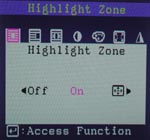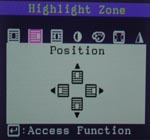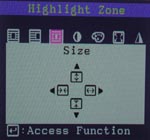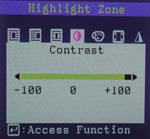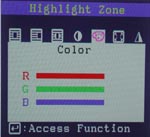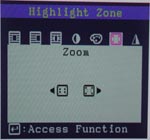
Original Link: https://www.anandtech.com/show/903
A monitor is perhaps the largest investment that a user commits to when purchasing or building a computer. Not only can a monitor cost hundreds of dollars, it is the least likely component to be replaced. Although advances in technology quickly render CPUs, video cards, and motherboards obsolete, a quality monitor can last years.
In addition to being a long term investment, one's monitor also plays an important role in the whole computing experience. A quality monitor can mean the difference between an enjoyable computing experience and one plagued with headaches and eye strain. Think about it. How much time does the average AnandTech reader spend using their computer? Hours upon hours a day. And what part of the computer serves as the central interface point? The monitor. A fast gaming computer is easily crippled by a small or slow monitor. In the same vein, a powerful workstation is quickly brought to its knees if blurry text or a low refresh rate prevent long periods of use.
For these reasons, deciding what monitor to buy is of the utmost importance. The problem is that most users can not devote the extended period of time necessary to evaluate and compare multiple monitors. There are no benchmarks that can rate one monitor over another like other computer components, nor are there any set tests with which a monitor can quickly be evaluated. For the most part, individuals deciding what monitor to buy either choose blindly or rely on the opinions of others.
In our first monitor review, we hope to provide you, the reader, with another opinion with which to rely on. Each monitor we receive will be put though a thorough AnandTech test that will explore the monitor, discuss its features and, most importantly, evaluate its image quality using both objective and subjective tests. By doing so, we hope to successfully rate any given monitor as well as help those on the market for a new monitor decide which is right for them.
Without further ado, let's get to our first monitor review which happens to be of the Samsung SyncMaster 955DF, a flat screen monitor for those on a budget.
Construction
The Samsung SyncMaster 955DF is a 19" monitor featuring Samsung's "DynaFlat" screen. Similar to Sony's Trinitron line, Samsung's DynaFlat monitors feature what Samsung touts as a perfectly flat picture tube; and from what we saw on the 955DF what Samsung says is true. The 955DF's screen is flat, perfectly flat, without any curves on the tube's surface. This eliminates the typical distortion seen on non-flat CRT displays, as the image is projected on a seemingly flat screen.
The DynaFlat tube used in the 955DF is an invar shadow mask display, which means it makes use of a perforated invar metal alloy sheet to direct the electron beam generated in the rear of the display. Invar is used because of its high heat resistance prevents distortion after prolonged use. Shadow mask displays differ from aperture grill displays, like the one used in the popular Trinitron tube, in the way that the electron beam is focused. Both display types use a thin sheet of metal to focus the electron beam but the metal in shadow mask displays is cut into small holes while the metal in aperture grill displays are cut into parallel vertical slots. Typically, shadow mask displays are more dimensionally accurate but produce duller images and colors than aperture grill displays. Fitting the trend, our tests found that the SyncMaster 955DF produced very crisp pictures, likely a result of it's tight 0.20mm dot pitch.
The DynaFlat tube also comes with an anti-reflective coating on the screen's surface. The coating proved to be very effective during use, as it significantly cut down on the amount of visible glare on the monitor's surface.
When placed in the case, the 19" tube produces an 18" viewable flat screen. Being a budget monitor, one limitation of the 955DF happens to be its maximum resolution and refresh rate. The monitor is capable of running at a resolution up to 1600x1200, however at this resolution it is limited to a refresh rate of 68Hz. This made the SyncMaster 955DF difficult to use at 1600x1200, as flicker was visibly present to our sensitive eyes. On top of the flicker, we also noticed that the 955DF lost quite a bit of sharpness going from 1280x1024 to 1600x1200. Some may find the 1600x1200 resolution too high for a 19" monitor, as text and icons can be somewhat hard to see, but those with good eye sight will likely appreciate the increased desktop space afforded by running at 1600x1200.
The typical rule is that the minimum refresh rate for a monitor at any given resolution is that it should be 75Hz or above. This puts the sweet spot of the 955DF at 1280x1024 where the monitor is able to support a refresh rate up to 80Hz. For those willing to sacrifice a bit more desktop space, the monitor runs at 1024x768 at 85Hz without a problem.
Although the SyncMaster 955DF has a rather small foot print, it does not quite qualify as a short tube monitor. The complete setup measures 18.4x19x18.3 inches and weighs in at a rather hefty 51.8 pounds. This makes the 955DF slightly smaller than comparable 19" monitors
The monitor offers one form of input: your standard 15-pin VGA cable that is built in. Being a monitor for those on a budget, the 955DF does not offer an unpluggable VGA cable nor does it offer a set of BNC connectors. We did not, however, experience any problems running the monitor on the built-in VGA cable, as the resolutions that the monitor supports will likely not benefit from a higher quality cable. Like most other monitors, power is provided by a 3 pin standard computer power plug.
Below is a summary of the 955DF's specifications.
|
Samsung SyncMaster 955DF | |
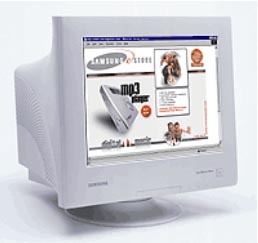 | |
| CRT |
19"
Samsung DynaFlat CRT INVAR Shadow mask pitch: 0.20mm (horizontal) Anti-static, anti-reflective coating 18.0" viewable area |
| Scanning Frequency |
Horizontal:
30-85kHz Vertical: 50-160Hz |
| Pixel Frequency |
135MHz |
| Compatibility |
1600x1200
/ 68, 65Hz 1280x1024 / 60, 70, 75, 80Hz 1024x768 / 60, 70, 75, 85Hz 800x600 / 56, 60, 72, 75, 85Hz 640x480 / 72, 75, 85Hz |
| Dimensions (WxHxD) |
18.4"
x 19.0" x 18.3" |
| Weight |
51.8 Lbs |
| Warranty |
3 years
parts and labor 3 years CRT |
Features
For a budget monitor, the Samsung 955DF packs in quite a lot of features. The monitor features 21 digital user controls that include most all the features we look for in monitors. Available in 9 languages, the controls are broken into 6 different on screen menus: Position/Size, Geometry, Color, Screen, Advanced, and Menu. Pictures of each menu are shown below. Beneath each picture is a list of the functions available in the menu as well as the selectable range.
|
| ||||||||||||||||||||||
|
| ||||||||||||||
|
| ||||||||||||||||||||||||
A few more advanced features were missing from the menu setup, the most important being a user definable color setting and a screen focus control.
Menus are navigated via the controls located on the bottom front of the monitor. Menu settings are navigated and altered using the 4 direction arrow keys, while two more buttons serve as entry and exit buttons for menu functions.

The final button on the front of the 955DF is the Highlight button which brings up a whole new set of menu functions. The highlight feature of the 955DF allows the user to set a portion or all of the screen to have different image qualities than the standard screen setup. For example, if you consistently find that your monitor looks too dark when watching movies but looks fine otherwise, one can use the highlight feature to brighten the portion of the screen where the movie is playing.
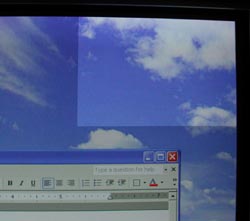
The highlight feature comes with 7 user definable settings arranged in seven screens. Below are screen shots of each feature as well as what the function does.
|
| ||||||||||||
|
| ||||||||||||
|
| ||||||||||||
Sharpness | |
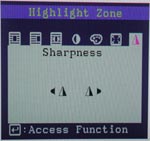 | |
| Sharpness | Sets the sharpness of the highlight zone |
All changes made in the highlight zone settings will affect only the image directly beneath the highlight zone. It is interesting to see that Samsung chose to include user selectable color settings for the highlight zone but not for the image on the whole. Left out of the highlight control settings are contrast and geometry controls.
Image Quality
To test out the Samsung 955DF we used the trusted standard of the monitor evaluation community: DisplayMate. Fitting on a 3.5" floppy, DisplayMate has set the standard for monitors as a result of its thorough tests. We decided to test the 955DF in the resolution we feel it should be run at: 1280x1024, the recommended resolution of the monitor. The refresh rate was set to 75Hz, Samsung's recommended refresh rate when at 1280x1024. Color depth was set to 32-bit.
For comparison purposes, we compared the Samsung SyncMaster 955DF with an older Samsung SyncMaster 950p which uses a different 19" shadow mask CRT. Below is a table with the tests performed and notes we made during testing.
DisplayMate | ||
Test | Monitor | Observations |
| Intensity range check | 955DF | Colors appear true, a bit warm |
| 950p | Colors look more "earthy" | |
| Black level adjustment | 955DF | Gray colors look good |
| 950p | Gray colors appear washed out | |
| Defocusing, blooming and halos check | 955DF | Sharper in high intensities but lines at the bottom of the screen wave |
| 950p | Not as sharp in high intensities | |
| Screen uniformity and color purity | 955DF | Uniform, pure color |
| 950p | Uniform, pure color | |
| Dark screen | 955DF | Anti-reflective coating really helped cut down on glare |
| 950p | More glare than the 955DF | |
| Primary colors | 955DF | Grays are slightly more pink |
| 950p | Slightly more saturated colors than the 955DF | |
| Color Scales | 955DF | Looks good |
| 950p | Looks good | |
| 16 intensity levels | 955DF | Looks good |
| 950p | Looks good | |
| Pincushion/barrel distortion | 955DF | Lines are much straighter as a result of the flat screen |
| 950p | Lines appear curved | |
| Geometric Linearity | 955DF | Lines appear straighter as a result of the flat screen |
| 950p | Lines appear curved | |
| Focus check | 955DF | No focus control, Image looks sharp but could be a bit sharper in the lower right corner |
| 950p | Focus control used to sharpen image | |
| Horizontal color registration | 955DF | Color misregistration on bottom right |
| 950p | Color mistregistration on whole right side | |
| Vertical color registration | 955DF | Looks good |
| 950p | Color misregistration on top right side of screen | |
| SMPTE color bar test pattern | 955DF | Colors appear warm |
| 950p | Colors slightly more saturated | |
| Fine line morie pattern | 955DF | Corrected via the user controls |
| 950p | Corrected via the user controls | |
| Screen regulation | 955DF | Flashing black/color pattern causes image to shrink and expand slightly |
| 950p | Looks fine | |
| Streaking and ghosting | 955DF | Slight ghosting behind bars of pure black/white |
| 950p | No ghosting observed | |
DisplayMate told us quite a bit about the 955DF. For the most part, the image on the 955DF was right on par with the image on the "professional" 950p. In fact, the 955DF looked better in many instances as a result of its flat screen. You may not think that the convexity of the screen makes much of a difference in image quality, but it can really make a difference in your viewing experience.
The 955DF was not without faults, however. Most notably were the monitor's lack of focus control, color registration problems, screen regulation and slight ghosting. The lack of focus control left a small portion of the screen at the bottom right slightly out of focus, although the problem was not noticeable under normal use. Color registration is a problem that plagues all monitors and occurs in areas where the 3 primary colors are not aligned properly on the screen. Misregistration is typically poorest on the periphery of the screen, especially in the corners, a fact which we observed on both the 950p as well as the 955DF. Again, the misregistration problem did not manifest itself to a noticeable amount outside of the intensive DisplayMate test.
Screen regulation was another area where the 955DF had a slight problem. On most monitors the image expands in size in areas of the screen that are bright and contracts in areas that are dim, but the degree to which this occurs varies from monitor to monitor. Turning down the brightness of a monitor will reduce problems with screen regulation, but this will also decrease the degree range of brightness generated. Ideally, the monitor should have little or no screen regulation issues in the ideal brightness setting determined earlier in the DisplayMate tests. As the observation notes, we had less of a problem with screen regulation on the 950p. There was also a bit of ghosting visible on the monitor when a sharp white image was displayed on a black background. Like all the limitations DisplayMate allowed us to see, the problem did not manifest itself during normal use.
We also tested the 955DF using a color checker. For this we used a Gretag Macbeth color checker which is a small chart that contains patches of scientifically true color. Included for each color is the computer value for the color, making it very easy to reproduce the proper color on the computer. We therefore created a TIFF image of the color chart at 1280x1024 and compared the image on the screen to the color checker.
Like we found using DisplayMate, the color chart appeared slightly more warm on the 955DF than it did on the 950p. Both monitors did produce a very good image that represented the actual color checker rather accurately.
Perhaps the best of of determining what we though of the monitor was using it. We used the 955DF to look at pictures, type in a word processor, and browse the web. We were extremely satisfied with the results: the 955DF at 1280x1024x32 at 75Hz did not disappoint.
Conclusion
The 955DF qualifies as a budget 19" monitor, especially considering the fact that it uses a flat CRT. Most retail stores price the 955DF at around the $300 mark, while online stores sell the 955DF for around $250 or less (not including the pricey shipping costs). As a budget monitor, the 955DF is about as good as they come.
The 955DF has a number of features that put it ahead of other monitors in this price range. In addition to having a very high quality picture tube that offers a perfectly flat image and a good anti reflective coating, the 955DF has a plethora of user controls. The highlight feature of the monitor also distinguishes it from the crowd, as the highlight zone can come in useful when watching a windowed movie on your screen. Most users will likely forget about this feature quickly simply due to the fact that the opportunity to use it comes fairly rarely.
Image quality wise, the 955DF did well in our tests. We were able to find a few problems with the monitor using DisplayMate, but on the whole none of the problems were noticeable in actual use. Perhaps the largest problem with the 955DF is its low refresh rate at 1600x1200. Many users find 1600x1200 too high of a resolution to use on a 19" monitor, but those with good eye sight will appreciate the extra desktop space gained by moving from 1280x1024 to 1600x1200. Unfortunately 1600x1200 is not an option on the 955DF since the monitor only supports a 68Hz refresh rate at this resolution. The 950p, on the other hand, is able to support a 75Hz refresh rate at 1600x1200. Those who are considering running at 1600x1200 on their 19" monitor should stay away from the 955DF.
Being a budget monitor, the 955DF also lacks some features that we would have liked to see. More advanced user controls, such as focus and a user definable color setting, would have been nice as would have a removable VGA cable and BNC inputs. Then again, there is only so much we can expect from a monitor priced in the sub $300 range.
Overall, the 955DF is an excellent monitor at an excellent price. If you are in the market for a 19" monitor that will run well at 1280x1024 and look great, do not hesitate to go with the Samsung SyncMaster 955DF.







